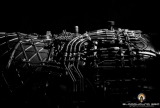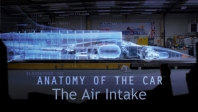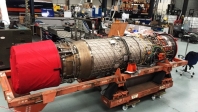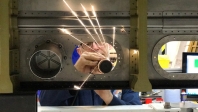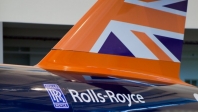The Team faced three main challenges when working out how to integrate the Eurojet EJ200 jet engine into BLOODHOUND, due to the significant differences between a fighter plane and a car:
- dealing with the electronic control of the engine
- avoiding surges in the air intake
- accessing the engine when it's in the Car.
Electronic control
Probably the most significant integration issue is controlling the engine. The EJ200 is designed to be a fully integrated component of a Eurofighter Typhoon, and so it has a highly sophisticated engine control and health monitoring system that is in constant conversation with the aircraft. Should it feel unhappy with the answer it gets to some of its questions, the engine gets set to a 'safe' mode with greatly reduced thrust.
The challenge when using it in BLOODHOUND is to convince the engine it is, in fact, happily sat in a Typhoon engine bay, and that going at Mach 1.4 at an altitude of 130mm is a sensible thing to do. Hence it's vital to ensure the jet engine is getting the correct data.
Avoiding surge
The next challenge was the design of the jet engine air intake. The intake has to be able to deliver the correct 'quality' of air to the compressor face to avoid any chance of the engine experiencing a 'surge'. Surge is when the compressor stage of the engine stalls, resulting in a reversal of flow through the engine, which would be an extremely violent and damaging event.
Jet engines have a defined surge margin, which ensures they are never run in regions of their operational 'envelope' where surge could be an issue. This margin allows for issues such as the intake icing up or sucking in a bird, or unsteady airflow caused by rapid manoeuvring. Hopefully most of these won’t be relevant to how the EJ200 is used in BLOODHOUND, so we have foresaken some of this margin for increased performance.
However, this is based on our confidence in the performance of the air intake, which is based in turn on the extensive computational fluid dynamics analysis used when designing the Car.
Accessing the engine in the Car
The final issue is getting access to the jet once it is inside the Car, as due to what we’re trying to achieve with BLOODHOUND, it simply isn't possible to install the EJ200 in a way that makes it easy to maintain.
BLOODHOUND has been designed so that all vital engine systems are accessible for safety checks prior to a run, such as oil and hydraulic level check and replenishment. Other routine tasks that are possible when the jet engine is sitting in the engine bay of a Typhoon plane will instead have to be done by taking the engine out of BLOODHOUND, but we hope that using the onboard engine health monitoring will enable us to predict and plan such maintenance requirements in advance.

